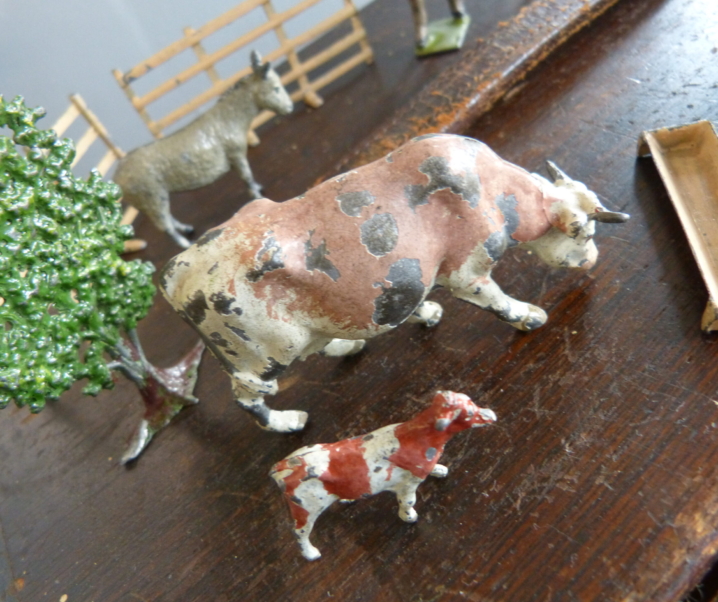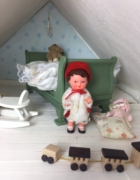Remember when toys were everything? When your small, boring childhood was rendered huge, magical and grown-up on the receipt of one amazing Christmas present? Clackers, space hoppers, Cinderella sandals and adjustable roller skates were up there but striding my world like a plastic-legged colossus was everyone’s favourite girl-next-door.
Sindy.

With her demure sideways glance and chubby cheeks, Sindy was the epitome of swinging Sixties Carnaby Road style but – forget free love and drugs – our Sindy was a good girl at heart.
Unless you were a child of the Sixties, it’s hard to understand how Sindy revolutionised playtime. Before 1963, dolls were babies or little children to be cuddled and nurtured. Sindy gave strictly disciplined pre-teens the chance to rehearse for a ‘liberated’ future filled with boys (not Paul – mine got down and dirty with Action Man), parties and clothes.
And what clothes. The bigwigs at Pedigree realised you could only sell one or two dolls to every girl; however the revenue stream from the Sindy extras – clothes/accessories/furniture/an annoying little sister Patch – was infinite. I can still recall the painful desperation of trying to get my mum up to the toy department in Woolworths to look at clothes. Then all those pledges that I would be good girl forever if I could get my sticky mitts on Sindy’s pink party dress with lace trim.

Given enough outfits and imagination, my Sindy could live a thousand different lives. She was Come Dancing contestant/smart legal secretary/Miss World winner/ballet dancer and snow queen and all in one afternoon. Sindy allowed little girls (me) to try on the adult world for size. I was going to be air hostess during the day (remember the dinky BOAC bag?), sexy girlfriend at night and an Olympic gold-winning gymnast on the weekend.
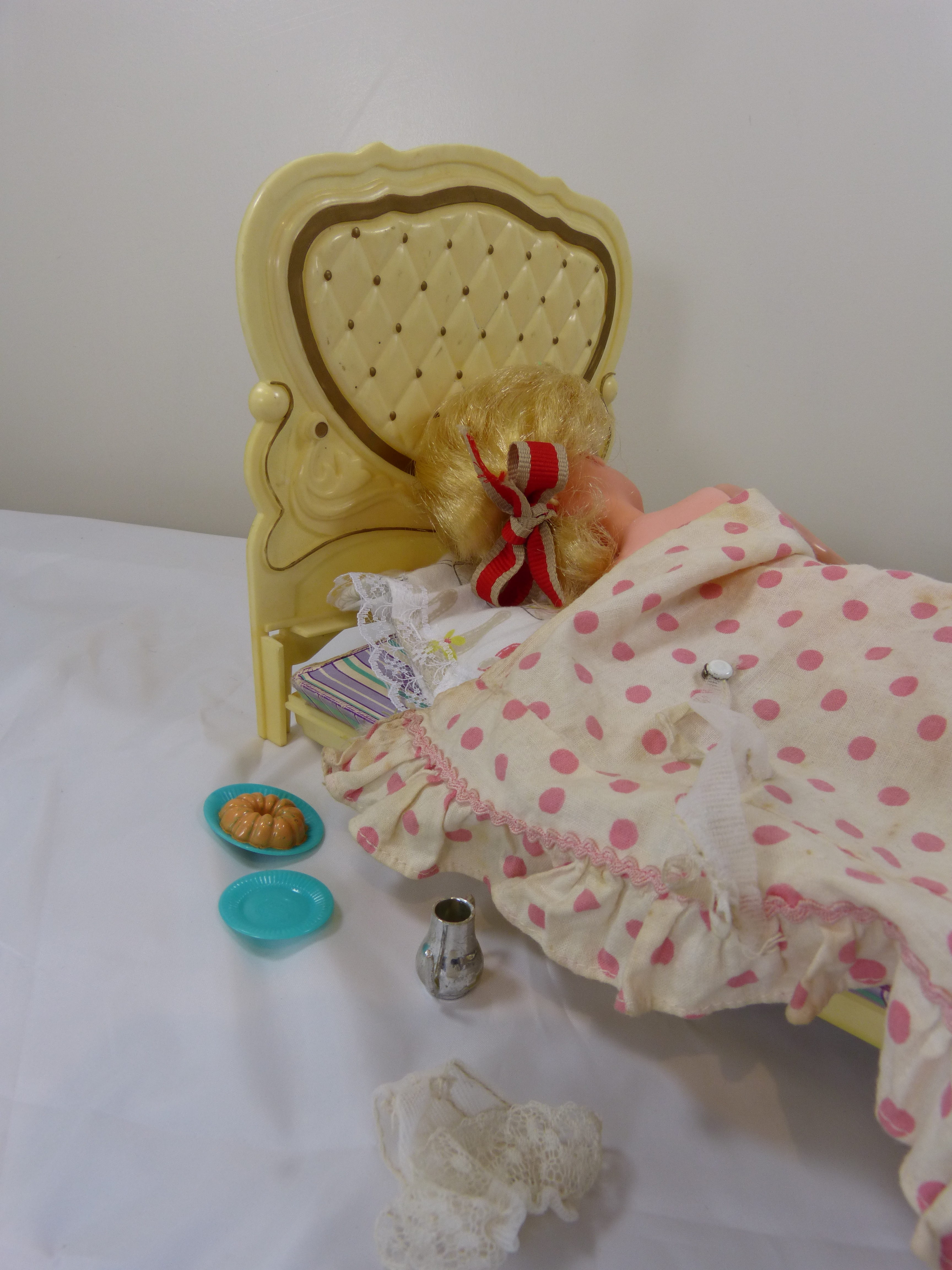
Understandably, I could hardly contain myself – never mind my wallet – when two Sindy lots came up at the local auction house. The first lot was a box full of dolls – circa 1960, early 70s. The second contained her accessories and ‘scene-setters’. Whoever owned these toys was a seriously lucky, pampered little girl. I was never allowed to have any scene-setters – the bedroom set, the picnic table, the horse and the sport’s car etc etc etc.


Most 1960s parents were mean. Even if they had spare cash, they didn’t waste any on ‘scene-setters’. If you were lucky, you got a few ‘carded’ outfits throughout the year and a boxed set of clothes (the ones with a whole outfit plus accessories) for Christmas. You’d sooner get the moon on a stick than Sindy’s horse. Even those little luxury extras like the paddling pool set was a no no; never mind the kitchen sink with matching apron and oven gloves.


I bid £85 for the dolls – and got nowhere near. I did get the the scene-setters accessories. In a strange quirk, I now own all the scene-setters and accessories my little heart once desired (my auction lot included a kitchen sink/picnic set/bath/wardrobe and bed with lots of accessories) but no Sindy doll.*
I dragged my son to the auction house with the promise of cake (he’s 20 but it still works). He quickly decided no Bakewell tart on earth was worth the humiliation of seeing his mum weeping with joy.
“What is it?” he asked, anticipating I’d found a stash of Roman gold wrapped in a Banksy cartoon.
“Clothes,” I managed to mumble. “Sindy’s wardrobe is full of clothes.”
“Okaaay – and that’s good because…”
It’s good because, put a certain vintage toy in our hands, and we 50-somethings are capable of time-travel. As I fondled the poppers on the back of the dresses – and marvelled over the tiny bra and pants set – I saw my childhood self sitting under a weeping willow tree in a sunny back-garden in Grimsby. I got a flash-back to the dreadful time I swapped a pile of shop-bought clothes for ones crocheted by a friend’s nan. I also recalled Christmas mornings spent ripping paper off presents in the uncertain hope of seeing Sindy’s pink and white packaging.

‘What happened to my Sindy?” I asked my dad recently.
“Landfill – you know what your mum was like,” he replied with a guilty blush.
Ah, I suspected as much. There came a time in the mid-70s when my childhood pal just disappeared. The high prices being realised on 60s/70s/80s Sindys shows mine was not the only one to suffer this terrible fate.
Sadly, I didn’t grow-up to fulfil my ‘Sindy life’. I cannot dance, ski or skate. I didn’t have the social skills to be an air hostess, the figure to be a gymnast and I’m terrified of horses. Frankly, I am a shy writer with no interest in clothes, make-up or girlie hobbies.
She’d be far too nice to say so – but I think Sindy would be a little disappointed.
*I missed out on two lots at auction and on countless dolls on eBay. Then Sindy and doll collector Helen O’Brien (see below) offered to send me a 1960s Sindy with the words “I know she’s going to a good home.”
That’s the thing about ‘Sindy’ girls – we’re still nice.

Sindy enthusiast Helen O’Brien, doll collector and designer of bespoke Sindy clothes. Helen runs the Instagram account @poorlittlenell
“This is one of my childhood Sindys; I call her Shirin-Sharon. She was given to me in the early 80s but I believe she was already secondhand and probably dates from the late 1970s. I originally called her Sharon but, two years later, I saw a character called Shirin in the Bunty magazine. I couldn’t part with the name Sharon – so ‘Shirin-Sharon’ was born. I remember my little brother trying to grab her and I said; “Hey don’t do that to Shirin-Sharon!” and he laughed so much – he couldn’t speak. We lived in Shetland at the time and it later turned out he thought I’d said a rather rude local word for poo.”

Shirin-Sharon is the kind of Sindy known as a “2-gen”. These dolls have ‘2 GEN 1077’ (see above) printed on the back of their head along with the usual Sindy serial number. These dolls, which date from the late 70s to early 80s, are my favourite kind of Sindy. When I was a child, Shirin-Sharon had wrecked blonde hair that had been hacked off short. In 2011, I found her in storage at my parents’ house and decided to reroot her hair. She is one of the first Sindys I rerooted and I’m happy with the results. I also redid her eyelashes and retouched her lipstick.

Shirin-Sharon is wearing a Sindy dress of an earlier era – namely a Dream Date dress from 1964. This is one of my favourite Sindy dresses because I found it about six years ago on a ‘Trendy Girl Sindy’ in a charity shop. The dress and Trendy Girl cost 50p – I am still delighted with this find because it’s rare to find a Sindy in the secondhand shops nowadays. I was so lucky as 1970s Trendy Girl Sindys are the most popular with collectors (it could be worth between £50-100).
I generally buy 2-Gen Sindys in poor condition and restore them by rerooting their hair and eyelashes and sewing them new clothes. For this kind of Sindy in scruffy condition I expect to pay between £6 and £10.

I used to run a small business selling doll’s clothes online and at festivals and fairs but, after my son Patrick was diagnosed with an on-going medical condition, I’ve had to cut this back. I now do two selling events a year. The first is the Meadows Festival in Edinburgh – where I sell Barbie and other fashion dolls and clothes that I have either made or restored. The second event is the famous ‘Dollycon’ where I sell Sindy dolls, restored clothes and my own bespoke outfits. Occasionally, I sell a few restored and original doll’s clothes on eBay.”

Meadows Fesitval takes place on June 2, 3rd 2018
Dollycon THE event for collectors of fashion dolls and Action figures, take place on July 28th at the Showroom Conference Centre in Lincoln

Sindy obsessives Renee and Lizzie Rose, of Coventry, run the scrumptious Instagram account @sindyobsessed
“We are twin sisters who have loved Sindy since we were little. Our first Sindys cost £1 from a car boot sale. The were ‘Active Sindys’ and our pride and joy. When we hit 40 – we decided to collect all the Sindy items we always wanted as children.


My Pedigree chum…a brief history of the Sindys from my childhood ie: the 1960s through to the mid-70s
Her name was chosen by her target audience – little girls. Company pollsters took to the streets to show youngsters a picture of their future doll and a selection of four names. ‘Cindy’ came out on top but ‘S’indy was thought to be a more distinctive trademark.

Sindy was launched via a series of advertisements in September 1963 (the first shown in the London area). Mattel had approached Pedigree Toys to offer them a licence to sell Barbie, with her implausible-bust-to-waist ratio. The company decided this sexy vamp was a little too ‘American’ for British gals.
The first Sindy was a blue-eyed, wholesome teenager, dressed in a colourful stripy red, white and blue top and parent-pleasing jeans. The Sindy advert appeared 25 time before Christmas but it was enough to turn thousands of heads. The Exeter-based Pedigree factory had to pull extra shifts to cope with demand. According to Ann Jalili and Kathleen Weatherhead (who collated the fabulous Our Sindy Museum) sales for dolls and products amounted to 200,000 in the three months to Christmas.
The first issue Sindy had a soft vinyl head topped by cute bobbed hair in auburn, brunette and blonde. She was marked ‘Made in England’ at the base of the neck. Our original girl was bendy, hollow legged and eleven and a half inches tall. She was an instant hit being awarded the coveted “Girl’s Toy of the Year’ in 1968 and 1970.


According to a 1964 Daily Mail article, Sindy’s hair style was created by Michael at ‘John of Knightsbridge’. Pedigree also approached top 60s designers Sally Tuffin and Marion Foale to design early outfits. The first Sindy wore a Tuffin & Foale ‘Weekenders’ combo of A-line jeans (hand-stitched piping) and stripy sailor-style top.
Tuffin and Foale also designed ‘Shopping in the Rain’, ‘Dream Date’ and the Jackie Kennedy inspired ‘Lunch date’ tartan and turtleneck twin-set.
Although her figure changed over the years – becoming slimmer – Sindy’s 1960s figure aligned to a UK size 10 with vital statistics 33-24-34.
Throughout the 60s/70s, Pedigree would tweak the dolls and introduce new mechanisms. Trendy Girl (launched in 1971), featured an ingenious neck knob (yes – really). Sindy could now turn her head all the way round. Her skin colour was prettier (less likely to bleach) and she had much better hair in a variety of shades including copper, dark brunette and almost grey. Another favourite was ‘Lovely Lively’ (1971). Bendier (thanks to additional rubber) slimmer and curiously flat-chested – Lovely Lively was smaller everywhere apart from her lashes.
Dolls from this period are highly desirable. Expect to pay around £50-£100 for a Trendy Girl and between £30 and £50 for a Lovely Lively. But pushing up the collector’s chart is ‘Top Pop Star’ – again from the early 70s. It’s so rare, it’s impossible to even value but a collector tells me she paid £600 for one without a box (a photograph of this doll in the catalogue sold for £9 on eBay and an outfit realised more than £100). Any kind of Sindy MIB ‘mint in box’ is going to be more sought after and valuable.



Sindy had an on-off relationship with boyfriend Paul. According to Our Sindy Museum (who managed to unearth a style guide) Paul was introduced on the scene with a back story. Apparently, our girl met him at a dance and she was attracted to his ‘pleasant but shy’ personality.
Paul (a thinly disguised Paul McCartney) had his own wardrobe of outfit including a duffel coat. His first outfit – a jeans and chunky jumper combo – was designed to match Sindy’s Weekenders’ look. In 1968, Paul was given rooted hair – collectors know him as ‘Hairy Paul’.
In spite of his cool Lambretta and sensible blazer and flannels, Paul was dumped at the end of 1968.
Our cold-hearted Sindy didn’t take up with her beau again until 1987; by which time he’d been given an American facelift; he was more Baywatch than Paul-next-door. Somehow or other, those Sindy boyfriends didn’t live up to the fantasy man we created for her in our own heads; fake tan notwithstanding; they were all a bit too wet.

In the 1960s, Sindy accessories accounted for 70 per cent of the sales. She had a bathroom – complete with a bath with running water, a sink with mini pots and pans and a glamorous bedroom set. Sindy’s dressing table came with an ever-changing variety of goodies including a record player, cosmetics, brush and comb sets and a vase. She has had dogs (Ringo and Rufus the red setter), a horse called Peanuts (complete with blanket and brush), a sport’s car and a four storey town house.

Collectors must take care not to confuse the valuable Trendy Girl with look-a-like ‘Funtime’ Sindy. Produced every year from 1975, ‘Funtime’ was a bargain basement Sindy – non-twistable waist, shorter arms and only available with blonde hair. Quite frankly, she was cheap (just don’t tell her mother).
Purists often point to 1974 as the seminal year for Sindy. Pedigree introduced a new new look (complete with elegant chignon and ribbon). This version became the most popular in the doll’s history (and remained unchanged into the 1980s).

Active Sindy featured a double twist waist, ball joints at the wrists and bending elbows and knees – but disappointingly stiff ankles. Lovely Lively (1974 version) was similarly lithe. By 1975, Active Sindy could even stand on tip toes.
In 1978, Sindy was launched on the American market. The so-called ‘Marx Sindy’ was an instant hit – predominantly because (unlike Barbie) of she came with lots of accessories and scene-setters. Sadly, the demise of Louis Marx & Co in 1980 led to Sindy being withdrawn from the American/Canadian market.


In May 2018 eBay listed a blonde 1978 Marx Sindy, in her original floral maxi dress. She sold for £25 (see above). Collectors are far more interested in Sindy’s American pal Gayle; she can command between £150-500 depending on condition and her outfit (£255 for a 1978 ballerina Gayle in her original box).
The most valuable Sindy outfits aren’t by Pedigree. They were sold separately by Mam’selle. These outfits are so fashionable and so rare; even a small accessory from the range can sell for around £75.

Sindy enthusiast and doll clothes maker Sarah Ellis lives in Wales. She runs the Instagram account @sewsindy
“My ‘obsession’ with Sindy started after receiving one for Christmas. I couldn’t wait to get home after school and play with my Sindy. She would come everywhere with me – holidays, visiting relations, days out with the family and of course she would be dressed in the outfit most appropriate for the trip.
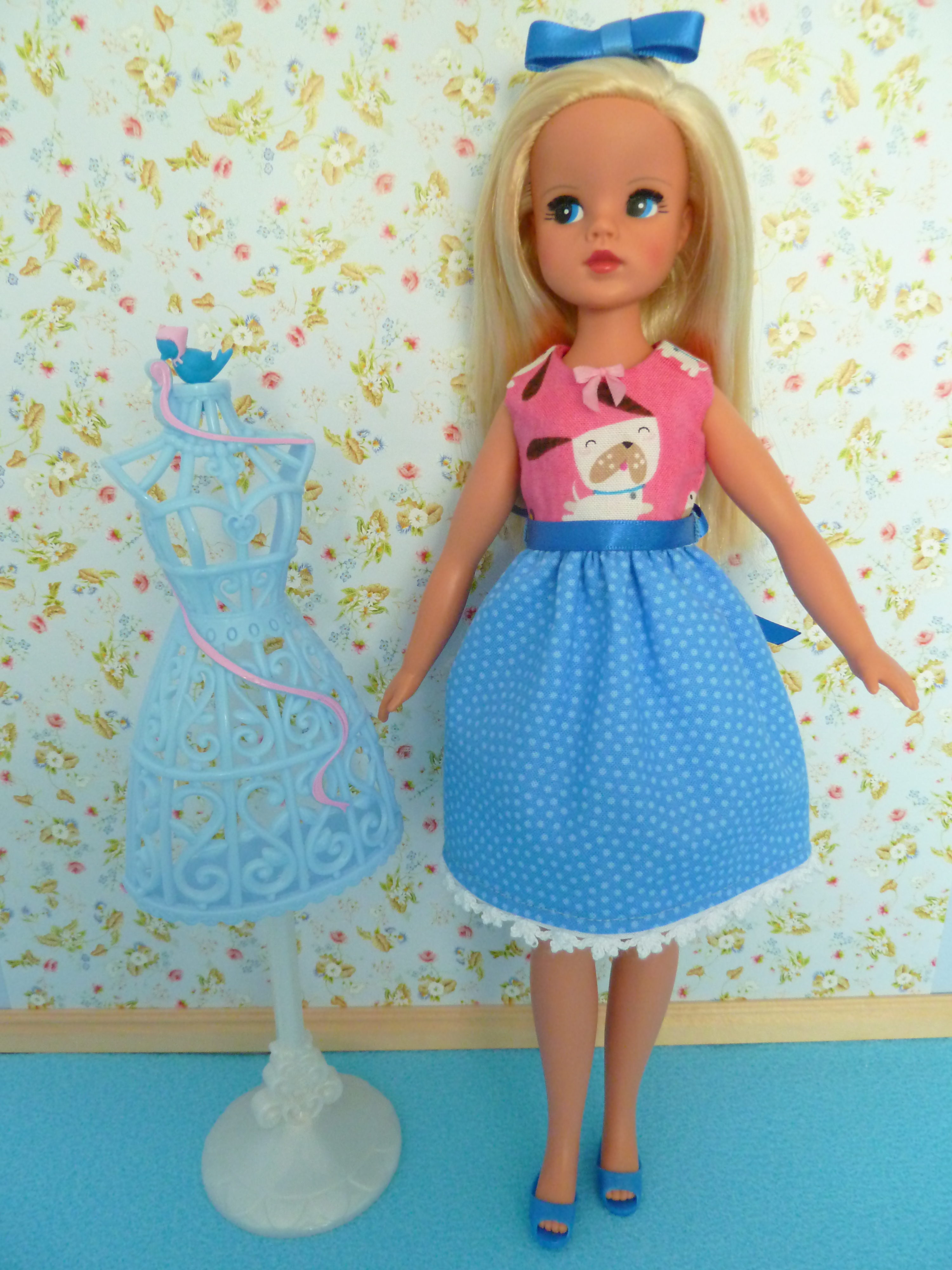
I’ve always enjoyed crafting and always loved fashion. My mum passed on her knitting and sewing skills to me when I was young and so my Sindy doll had plenty of homemade outfits to wear.
After 35 years, my obsession returned. A few years ago I got into doll’s houses and ,whilst looking on eBay for miniatures, I came across Sindy dolls for sale. Instantly my heart melted. All those wonderful memories of playing with my favourite doll came flooding back. That evening I mentioned to my boyfriend that I’d seen these dolls for sale and all the wonderful times I had with her. Few weeks later he presented me with a Sindy doll and said ‘It’s time to make some new memories’.

When I made clothes for my Sindy doll as a child there where no expectations, no demands, no worries. I lived in the moment – creating and imagining. It’s exactly the same as an adult making clothes for her. Everyone needs time and space in their lives to be able to create and dream, with no pressures. Sindy helps me to escape.
After my love for Sindy was re-ignited, I soon found out I wasn’t the only ‘adult’ on Instagram who was Sindy obsessed. It’s great that we can all share our love for Sindy through pictures and little stories, it’s so much fun…”
Buyers beware. If you are collecting Sindy dolls then condition is all. While is is not necessary for your Sindy to be NRFB (never removed from box), there are common problems which may devalue your heirloom.

- mad/missing hair – it was tempting to style Sindy’s hair and early models had nylon plugs which turned to frizz if brushed. It also fell out if man-handled…there are countless Youtube videos telling to you how to re-root hair plugs into Sindy’s head. Another problem is the over-zealous ‘fringe’ trim; a lot of little girls (me) thought it was fun to turn hairdresser and snip away at Sindy until the poor thing was half-scalped.
- body art – not tattoos, just pen and crayon marks to the face and body – a crime often committed by naughty little sisters.
- missing digits – Sindy’s feet and hands were just so squidgy; it was impossible NOT to gnaw…hence a lot of vintage dolls have pitted or missing digits.
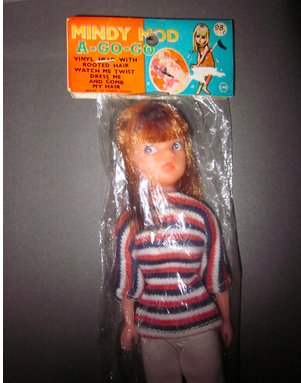
Mindy Mod ‘a no no’ – does she remind you of anyone? - Pale face – the vinyl on the early dolls tended to go pale in the light. A lot of 1960s dolls have tan lines below the neck.
- Mis-matches – heads are often replaced and therefore on the wrong body and body parts from earlier dolls were sometimes used on newer models – leading to weird anomalies (my Sindy has short arms which seem to come from her sister Patch). Then you have ‘clones’ – cheap copies from the Far East. For instance, on The Land of Clones website, you can see a ‘Mindy Mod’ made in Hong Kong; a cheap, rip-off Sindy down to the ‘Weekenders’ outfit. Just to add to the brain-strain; clones have become collectible in their own right…yes, collecting Sindys can be an absolute minefield.
- Able-bodied – check her limb movements; if she’s an Active Sindy – do the legs still bend, can she still do the twist – has she got a hand missing? (I have seen this on eBay)

This dolly is extremely Jolly – her clever owner can make designer clothes Sindy enthusiast Cathy Howard, of Somerset, runs Jolly dolly shop; designing and making clothes for teenage dolls like Sindy. Follow Cathy’s Instagram account to see more Sindy action, or visit the Etsy shop.
“A few years ago I started a business called Jolly Dolly Shop which sees me designing and making vintage style dolls clothes. Initially I made clothes for children to play with, then for adults, and now I sell worldwide. Nostalgia for my childhood Sindy and those fashions made her perfect as a model.
I also restore and customise Sindys that have seen better days. Sometimes they arrive bald and scribbled on, sometimes they’re just well loved, and it’s satisfying to give them a new lease of life.
This Sindy encompasses everything I love about Sindy dolls. She was an attic find given to me by a lovely friend, that I rerooted. She’s wearing an outfit I had with my first ever Sindy ( good old Father Christmas!) perfect for adventures. Therefore she represents three things, friendship, childhood and vintage style.
What more could you ask from a doll?”


I had three beautiful Sindy evening outfits when I was young – First Night, Night Spot and Premier Girl. None of them survived. I am on the look out for them because I remember them from childhood and they have good memories attached. However, the dress she has on is the next best thing – I found this ball gown in a charity shop for 50p! I recognised it immediately as a Sindy outfit so I jumped on it (how could I not at that price?) I remember this dress from the early 80s and, though I never had it, I loved all the Sindy ball gowns.
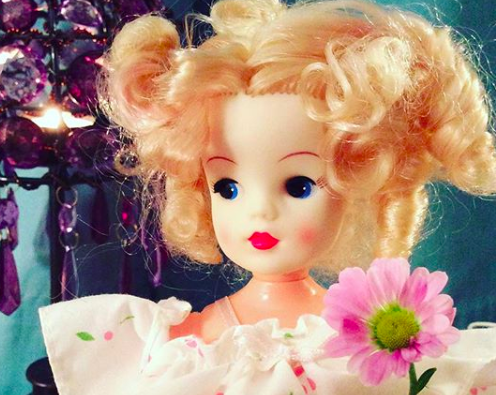

What’s she worth? Collectors are looking for first early issues with original clothes and accessories, unusual hair colours (it pays to be a red head) and rare models like Top Pop (1973; the rarer of the two outfits being the abstract design top according to Our Sindy Museum ). But value is often lies in the eye of the buyer – people who are buying Sindy for reasons of nostalgia (or to complete a collection/outfit) invariably want dolls and clothes from a particular era and will not be as fussy about condition.
Two days in May; Here’s a selection of Sindy dolls which appeared recently on eBay on May 10 and 11th 2018 with their sold prices.








Sources:
eBay – just search for ‘Sindy’ – there is a lot available but don’t expect to see too many bargains
If you are new to Sindy collecting or wish to date/value your own dolls/outfits; try Facebook groups. A great place to start is the official Pedigree site Vintage Sindy
For answers to even the most obscure Sindy questions; try Sindy the doll you love to dress on Facebook
For the definitive world of Petra, Sindy and Barbie – visit Linda Clark’s Petra dolls; a wonderful repository of vintage dolls and outfits.
Our Sindy Museum I think I may have mentioned how brilliant this site is for identifying Sindy models.
There’s also a well researched article on Tuffin and Foale on The Sindy Doll Collection website – including pictures of Sindy’s famous designer duo.
Also a big thank you to all the collectors who gave me their time – and photographs. Special thanks to Helen aka @poorlittlenell – not only providing her story and loads of info – but she sent me a SINDY as well.





